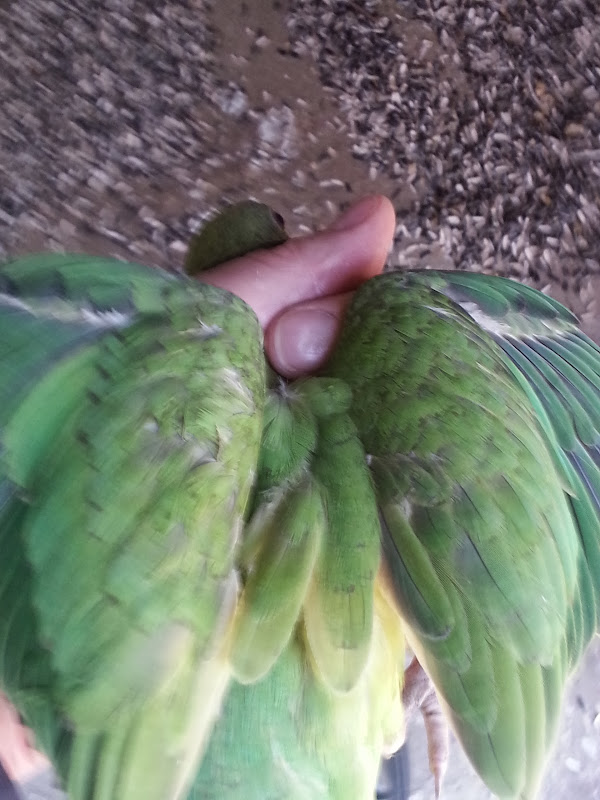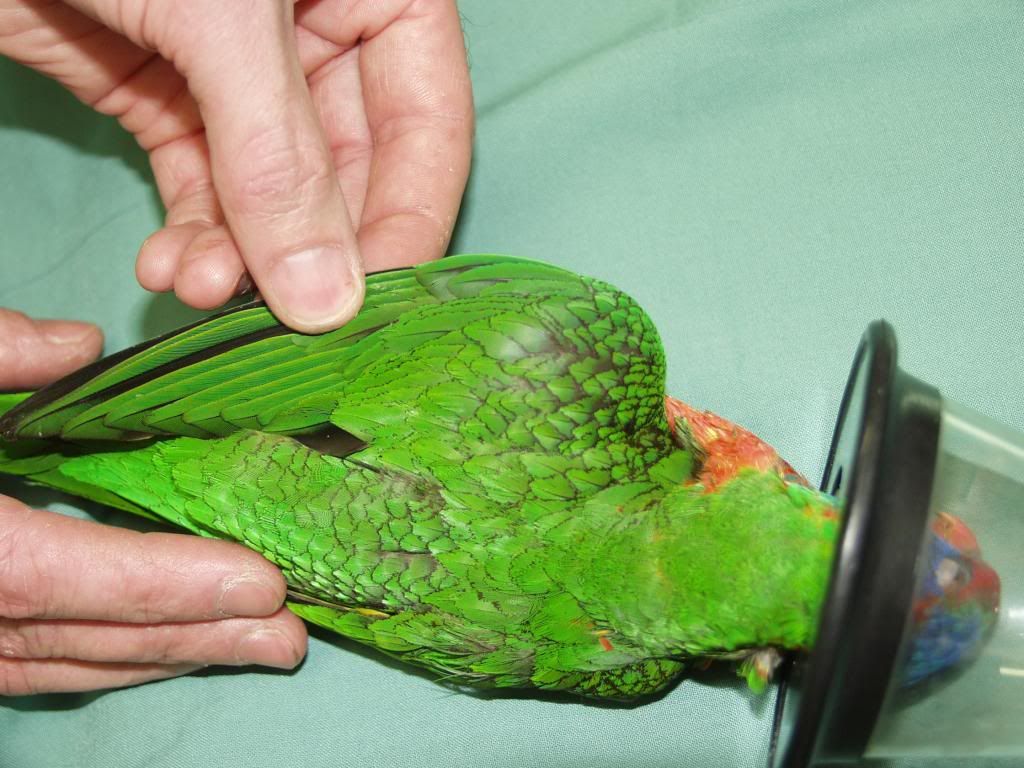Page 1 of 1
Odd markings?
Posted: Sun Nov 03, 2013 11:59 pm
by SCB 22
Re: Odd markings?
Posted: Mon Nov 04, 2013 3:17 am
by SCB 22
Re: Odd markings?
Posted: Mon Nov 04, 2013 6:52 am
by Recio
Hi SCB,
Can you tell us if your bird has also these markings on her face? On the 1st pic I can not see any marking on her face but on the 4th pic I am not so sure.
Regards
Recio
Re: Odd markings?
Posted: Mon Nov 04, 2013 7:55 am
by SCB 22
She has one or 2 of the marks but not as dark on the one side of her head/ face that you can vaguely see in that one pic
Re: Odd markings?
Posted: Mon Nov 04, 2013 9:38 am
by Recio
Hi SCB;
You have a red bird. Do you know why? ... Such a lucky woman you are.
Regards
Recio
Re: Odd markings?
Posted: Mon Nov 04, 2013 11:08 am
by prodigy
Hi
What markings are we talking about ?
As per the below?


Re: Odd markings?
Posted: Mon Nov 04, 2013 1:40 pm
by Recio
Hi SCB,
Your bird dysplays those markings following a patched psittacin pattern (or a turquoise pattern): increased amount on the coverts of the wings and head, time dependent expression with markings increasing with age and an "inside the feather" distribution pattern typical of psittacins (higher amount on the tip of the feather). It is in these areas where psittacin concentration is maximal and fluorescent psittacin is higher. It is also in these areas where red psittacin is more likely to be produced (threshold theory). The red psittacin in a bird owing melanin will appear as a brown/grey colour (your odd markings = blue + red). If you want to test for the presence of red psittacin you should pair your feamle to a SL-ino cock in order to get red-ino females on the first generation.
Do you know if any of the parents of your bird had also those markings? Do you know if the parents are/carry pied mutation(s)? Red birds seem to follow a dominant pattern and, thus, one of the parents should have shown those markings.
Try to get a look at your bird under uv and compare it to a normal green. Probably her fluorescence will be higher due to increased psittacin production and probably the odd markings will not be fluorescent since no one fluorescent red psittacin has ever been reported.
Regards
Recio
@Peter: I can not see clearly the markings of your bird but if it belongs to your red line ... probably it is a red bird.
Re: Odd markings?
Posted: Mon Nov 04, 2013 3:57 pm
by trabots
The feathers are clearly ragged at the ends. They are not mutant feathers they are damaged feathers IMO. I have had plenty of these feathers over the years.

Re: Odd markings?
Posted: Mon Nov 04, 2013 10:16 pm
by SCB 22
Recio wrote:Hi SCB,
Your bird dysplays those markings following a patched psittacin pattern (or a turquoise pattern): increased amount on the coverts of the wings and head, time dependent expression with markings increasing with age and an "inside the feather" distribution pattern typical of psittacins (higher amount on the tip of the feather). It is in these areas where psittacin concentration is maximal and fluorescent psittacin is higher. It is also in these areas where red psittacin is more likely to be produced (threshold theory). The red psittacin in a bird owing melanin will appear as a brown/grey colour (your odd markings = blue + red). If you want to test for the presence of red psittacin you should pair your feamle to a SL-ino cock in order to get red-ino females on the first generation.
Do you know if any of the parents of your bird had also those markings? Do you know if the parents are/carry pied mutation(s)? Red birds seem to follow a dominant pattern and, thus, one of the parents should have shown those markings.
Try to get a look at your bird under uv and compare it to a normal green. Probably her fluorescence will be higher due to increased psittacin production and probably the odd markings will not be fluorescent since no one fluorescent red psittacin has ever been reported.
Regards
Recio
@Peter: I can not see clearly the markings of your bird but if it belongs to your red line ... probably it is a red bird.
Hi Recio,
The hen was an unknown bird bought in a pet store when she had no feathers, and turned out to be the green cinnamon edged bird, the cock was a green and to my knowledge his parents were both green as well.
I am trying to see if the male siblings marking have grown more / darker since this years moult as well.
Would it be ok to test breed to siblings to see if they pass it down? They are only a year old now?
Thank You
Re: Odd markings?
Posted: Tue Nov 05, 2013 3:27 am
by Recio
trabots wrote:The feathers are clearly ragged at the ends. They are not mutant feathers they are damaged feathers IMO. I have had plenty of these feathers over the years.

Hi Willy,
As you know I know less than nothing about lorikets ... but let's go in deep water:
Your loriket seems to show the same ragged feathers independently of their anatomical location. If they were damaged feathers I would have expected to find them specially at the more exposed areas and not on an almost even distribution. Flying and (I guess) tail feathers, which show a different feather structure, they are not affected despite that they are more exposed. All this makes me think that probably your lorikets show some kind of structural change (mutation?). It is not clear at all from your pic whether there is a black tip edge (feathers on the saddle area) or whether it is just the shadow on the underfeather (feathers near the tail do not show the dark tip edge despite that they appear broken). So I would not comment on psittacine control. You say that you have had many birds with this kind of feathers .... were they genetically related?
You said that, in your birds, this is a transition condition probably related to a diet problem ... but I am not really confident with this idea since you have other birds in the same conditions and they are doing fine. Let's have in mind that birds feathers structure changes with age. It is not only psittacin expression which depends on age but also feather structure (Ex: the iridiscence of the head and wings feathers in normal IRN is enhanced in adult birds respective to youngs, and it mainly depends on feather structure). Maybe your birds show a structural mutation which is only apparent in young birds and disappears later when they moult into an adult condition, and thus, it would not be related to any change in diet.
SCB bird does not show (on my screen) any apparent change in feather structure (no broken tips), just a distal darkening mainly on covert feathers. Nevertheless Peter's bird (despite the bad quality, sorry Peter

) seems to dysplay the same type of change in feather structure than your loriket... but really hard to say on those pics.
In your birds the broken feathers disappear after moulting. In SCB's bird the darkening of the tips increases after moulting. In your birds the broken feathers distribution is almost even. In SCB's bird the distribution matches patched parblue distribution of psittacins. In your birds the feather appears clearly broken. In SCB's bird the feathers do not seem broken but just with a darker tip. I do not really think that this is the same condition ... or mutation (?).
Regards
Recio
Re: Odd markings?
Posted: Tue Nov 05, 2013 5:15 am
by trabots
Recio, here is another image. The feathers may moult in devoid of structure and pigment but they are also brittle and then get ragged from preening as time goes on. It seemed diet related because the lorikeets involved improved in my aviaries. I never bred one myself. A galah I have had for 18 years had brittle feathers for 15 of those years without discolouration but then improved to perfection after putting all my birds on Vetafarm pellets 3 years ago. You can see in this image raggedness on unmarked feathers also. I see birds like this all the time in the bird dealers' and am convinced that diet is the factor despite the following bird.
I can see raggedness in the subject bird and in many of the others posted here. I had a Red Capped parrot exactly the same as this one which was otherwise healthy and was the only such feather defect in the 100 bird flight... until a Carpet python had her for a night time snack. He couldn't get out after due to the bulge. I didn't kill the snake by the way.


I can not see clearly the markings of your bird but if it belongs to your red line ... probably it is a red bird.
This is what red suffusion in a green bird looks like Recio.

Re: Odd markings?
Posted: Tue Nov 05, 2013 6:07 am
by Recio
trabots wrote:This is what red suffusion in a green bird looks like Recio.

Hi Willy,
I agree that, for your lorikets, probably it was a diet problem. Anyway SCB bird's findings do not match the features of the lorikets. What did you do to the python?
In the above image you can see that the red suffusion appears at places where yellow psittacins are already present in high amounts in non mutated birds (the bird besides to compare with): the belly, the neck, ... Since the distribution of psittacins is species depending I would not expect IRN and lorikets to show a similar pattern, but, in both of them, I would expect the red psittacin to appear at places where yellow psittacin production is already maximal, that is belly and neck in lorikets, and patched psittacin (tip of covert feathers) in IRN (like the odd markings of SCB's IRN).
Regards
Recio
Re: Odd markings?
Posted: Tue Nov 05, 2013 6:12 pm
by trabots
What did you do to the python?
Took him for a ride and let him slither away. I would have liked to keep him however here in Oz you can get a pretty big fine for keeping native species without permits etc.
Re: Odd markings?
Posted: Wed Nov 06, 2013 9:16 am
by Skyes_crew
This subject was discussed a little bit at the end of this thread
http://www.indianringneck.com/forum/vie ... 9&start=50
I supplied an article on fault barring
http://www.birdresearch.dk/unilang/faul ... ltbar5.pdf
Is it possible to get a feather sample? Maybe a look under a microscope will give more clues.


















